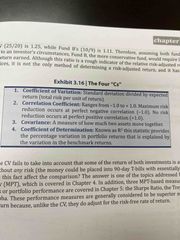![]()
![]()
![]()
Use LEFT and RIGHT arrow keys to navigate between flashcards;
Use UP and DOWN arrow keys to flip the card;
H to show hint;
A reads text to speech;
23 Cards in this Set
- Front
- Back
|
Arithmetic return |
Simple average Add up returns divide by number of returns |
|
|
Geometric return |
Calculates average return assuming all earnings remain invested Same as IRR When returns don’t vary yr to yr it is same as arithmetic mean, if they do arithmetic will always be greater |
|
|
Geometric return formula/ calculation |
Returns: 45%, -10%, -25%, 30% [1.45x.90x.75x1.30] ^1/4 -1= 0.062 4 returns = 1/4 power |
|
|
After-tax return |
Realized taxable return X (1-marginal income tax rate) 8% corp, 30% tax rate .08X (1-.30)= .08 x .70= 5.6% |
|
|
Systematic risks |
Can not be avoided Purchasing power Reinvestment rate Interest Rate Market Risk Exchange Rate |
|
|
Standard deviation and beta |
Std: includes systematic and unsystematic risk Beta: measures systematic risk |
|
|
Variance |
Std deviation squared Higher variance = higher risk |
|
|
Skewness |
Measure of lack of symmetry for a data set Positive: mean greater than median |
|
|
Kurtosis |
Measure of whether data are heavily tailed or light tailed Leptokurtic: high peak, fat tails Platykurtic: low peak, thin tails |
|
|
Correlation coefficient |
Determines level of diversification in portfolio +1= perfect positive +.50 = positive relationship 0= no relationship -.50= negative relationship -1 = perfect negative relationship |
|
|
Covariance |
A measure of how much 2 assets move together Not as intuitive as CC Not constrained to -1 & 1 like CC |
|
|
Covariance formula |
Std dev asset A x std dev asset B x correlation between both assets |
|
|
Semivariance |
Only takes into consideration of volatility below the mean return |
|
|
Coefficient of Determination |
R^2 Provides % variation in portfolio returns that is explained by the variation in benchmark returns, range is 0 to 1.00 Ex: Yankees baseball team 43% or R^2 .43 which means 43% of change in one variable is explained by changes in the other (height & weight) |
|
|
Coefficient of Variation (CV) |
Securities return relative to its risk Std deviation divided by expected return Fails to adjust for risk-free rate of return |
|
|
Dollar weighted return vs Time weighted return |
Dollar looks at the investors return Time looks at the investments return Use IRR to calculate both |
|
|
Annualized return |
Same as compound rate of return & assumes cash flow are reinvested at same rate Ex: 3% quarterly return (1.03^4) -1= .01255= 12.55% Ex: 6% semiannual return (1.06^2)-1= 0.1236= 12.36% |
|
|
Effective Annual Rate of Return |
(1+ ann rate/# of pd)^# of pd-1 Ex: 7% compound weekly (1+ .07/52)^52-1= (1.0013)^ 52 - 1= .07246= 7.25% |
|
|
Beta calculation |
Std dev of port X correlation divided by std dev of market |
|
|
Diversification |
Comparing the variability of a portfolio is returned to the market indicates Diversification |
|
|
Weighted average return |
They combined return of a portfolio |
|
|
Adjusted for correlation |
The combine standard deviation of a portfolio is the weighted average |
|
|
The Four Cs |

Back (Definition) |

